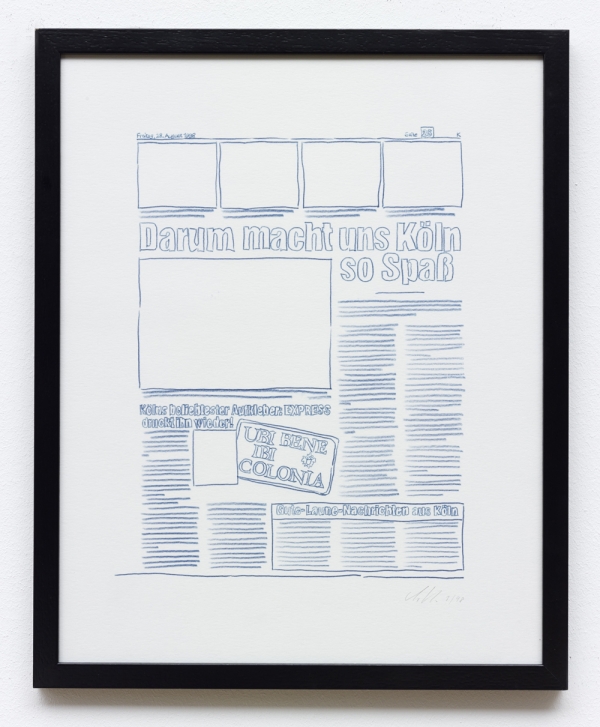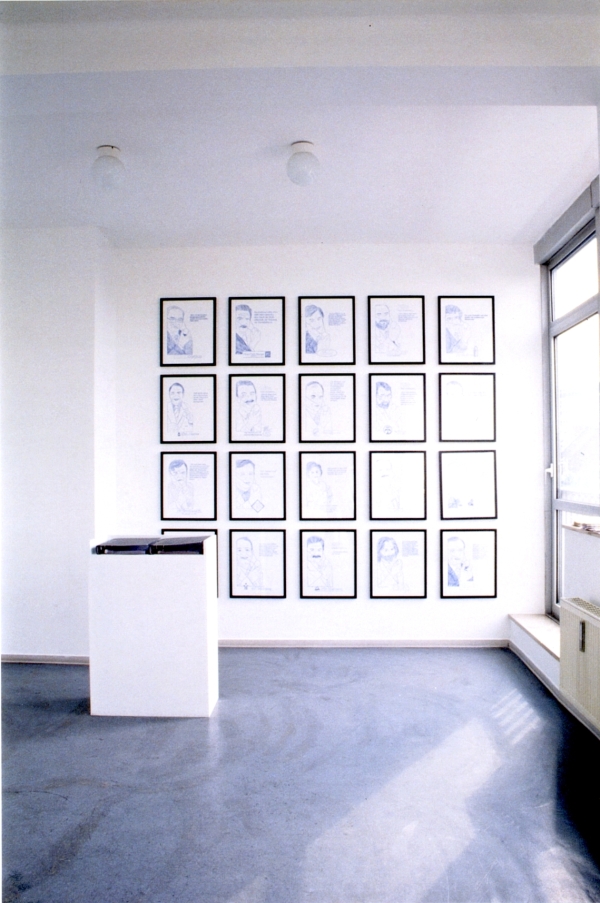
Installation of “Köln macht Zukunft” at Art Cologne, April 2016.
“International Commitment,” 1998.
Detail, “International Commitment,” 1998.
“Darum macht uns Köln so spaß,” 1998.
“Köln macht Zukunft,” 1998.
Detail, “Köln macht Zukunft,” 1998.
Imagetransfer
4 September – 5 October 1998
Galerie Christian Nagel, Cologne
“International Commitment,” 1998.
- 16 blueprints on white paper, 52.8 x 72.8 cm each
- Pedestal with two binders
- Correspondence in English with 16 international companies based in Cologne
“Köln macht Zukunft,” 1998. - 20 blueprints on white paper, 72.8 x 52.8 cm each
- Pedestal with two binders
- Correspondence in German with 20 local companies
“Darum macht uns Köln so Spaß,” 1998.
- Blueprint on white paper, 40 x 50 cm
“Profile Cologne, Quality of Life,” 1998.
- Blueprint on white paper, 50 x 70 cm
“Profile Cologne, Quality of Life,” 1998.
- Blue screen print, edition 20 + 5, 50 x 70 cm each
“Theme Song,” 1998.
- Color photo and text, framed, 30 x 40 cm
“Köln–Düsseldorf,” 1990.
- Computer graphics and photographs in canvas folder, edition 5/II
Müller’s exhibition “Imagetransfer” considered the cultural status of the city of Cologne, its cultural sponsorship, and the often-fraught relationship between economic and cultural activities. The timing of the exhibition coincided with an exodus of artists, galleries, and collectors from Cologne, a former cultural “capital” in West Germany, for the bourgeoning city of Berlin. The artist addressed this loss by considering how art and culture were referenced in two image campaigns sponsored by the Chamber of Industry and Commerce in conjunction with the city of Cologne aimed at retaining businesses.
The exhibition consisted principally of two installations (both 1998) each consisting of a grid of drawings in front of which Müller placed a pedestal. For the horizontal arrangement, “International Commitment,” Müller referenced a brochure entitled “ColognePlus,” in which representatives of large international businesses with offices in the city outlined its economic advantages. The second, vertical installation, “Köln macht Zukunft” (Cologne Makes the Future), was based on a brochure from a large-scale public ad campaign that promoted the economic value of the city’s three main attractions: "Kunst, Kirche und Karneval" (art, church, and carnival). Using tracing paper, Müller transferred the portraits and quotations of the companies’ representatives found in the brochures onto cardboard.
The title of the exhibition, “Imagetransfer” has a multi-layered meaning in relationship to the technique and content of the prints. Müller literally transferred the images from the brochure in through the act of tracing while at the same time reframing them within an art context. However, the work is also a commentary on the function of cultural sponsorship. Using concepts developed by Pierre Bourdieu, Müller visualized the exchange of cultural and economic capital that took place between the art and business worlds in the image campaigns. The idea that corporations could use culture to enhance their reputation was also a key element of Hans Haacke’s work since the late 1960s, which Müller used as a reference for “Imagetransfer.”
On the podiums in front of the drawings, Müller placed one binder containing questions he posed to the companies regarding their corporate sponsorship activities and the other with their responses. The exchange revealed the depth of their corporate policies not contained within the brochures: some misconstrued Müller’s letter as a sponsorship request while others admitted to promoting only high profile events.
This exhibition developed out of Müller’s previous exhibition at Galerie Christian Nagel, “Köln–Düsseldorf” (1990), in which he compared the downward trend in cultural expenditures in the two cities between 1967 and 1990. Eight years later, “Imagetransfer” was a further commentary on the interaction between public and private over cultural concerns and recent budget cuts in the arts.
Text by Cara Jordan




